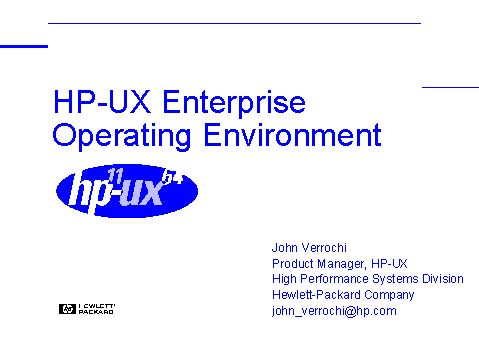

Hewlett Packard Company
19111 Pruneridge Avenue, MS 44M6
Cupertino, CA 95014
Phone: 408 447-1586
Fax: 408 447-5730
E-mail: john_verrochi@hp.com
A white paper presented to HP World 98,
San Diego, August, 1998

Executive summary
Hewlett-Packard’s HP-UX enterprise operating environment leads the market by many key measures:
HP-UX 11.0, which began shipping in November, 1997, is HP’s complete 64-bit operating environment that delivers tremendous scalability and performance for demanding applications. When teamed with HP’s leading server systems, HP-UX 11.00 provides the power of supercomputing at a fraction of the cost. HP-UX 11.00 on HP’s V-class server delivers the industry’s highest performance results.
This paper provides an overview of HP-UX, and describes the key features and functionality of HP-UX 10.20 and 11.0, HP’s two strategic HP-UX platforms. It then outlines HP’s future plans for HP-UX by providing a roadmap that describes mapping of hardware support and selected OS features over the next year and a half, culminating in the introduction of HP’s IA-64-based systems.
Setting the stage: HP’s presence in the UNIX market
According to industry analyst Aberdeen Group, HP’s share of the commercial RISC/UNIX server market was 52% in 1996, and its 34% revenue growth was 6 percentage points greater than that of the market overall.
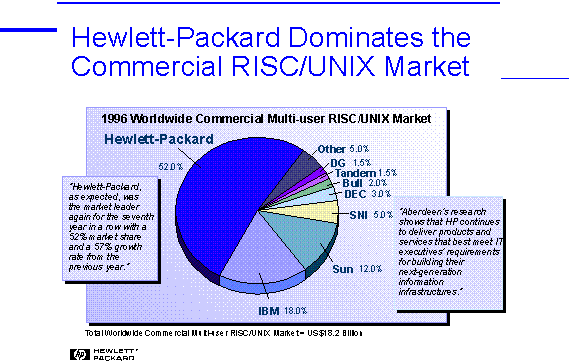
HP’s dominant position in the commercial RISC/UNIX space is the result of the firm’s R&D investments that lead to its providing customers with industry-leading products and solutions throughout the value chain, ranging from PA-RISC processors, to systems and networking, to HP-UX and middleware, to support services.
HP’s large share in this market reflects its longstanding investment in HP-UX, to which it is very committed. HP spends several tens of millions dollars annually on the development of HP-UX and related application software. Several thousand software development engineers are devoted to this effort. In addition to its own commitment to HP-UX, HP has strategic relationships in place with several industry partners for technology sharing and exchange with regard to HP-UX. These partnerhips, with Hitachi, NEC, and Stratus, have the aim of further extending HP-UX’s strengths in the high end of the UNIX market.
HP-UX 11.00 constitutes a major advance for HP-UX, and indeed all of UNIX. Industry analysts, ISVs, and end customers appear to agree. Gartner Group, the industry’s leading industry analyst, reviewed the major enterprise operating systems, and ranked HP-UX the highest. The chart below summarizes Gartner’s analysis.
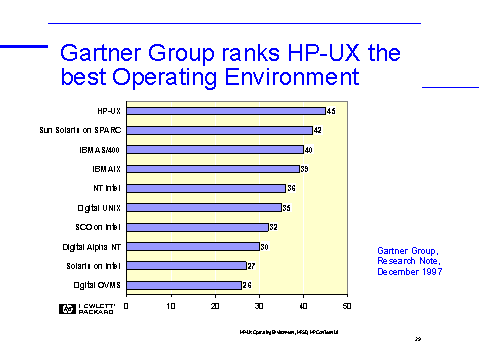
In addition to industry consultants’ favorable reviews, HP-UX 11.00 is attracting a growing list of ISV applications. Since its launch, the major database firms and other leading ISVs have developed versions of their software for HP-UX 11.0, maximizing its functionality.
Overview of HP-UX
HP’s PRISM framework describes how HP-UX meets the mission-critical needs of the large enterprise. PRISM stands for Performance and scalability; Resilience, or high availability; Integration; Security; and Manageability. PRISM applies to both the core operating system and complementary HP applications software, or middleware, that together comprise the HP-UX operating environment.
Extensions to PRISM—PRISM plus—include investment protection, and breadth of the applications portfolio. HP-UX 11.00 provides industry-leading features and functionality in every aspect of PRISM.
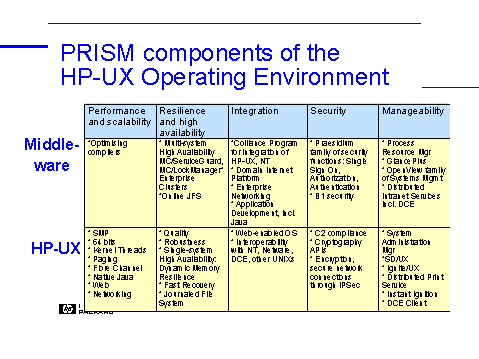
Performance and scalability
HP-UX is suitable for a broad range of business information technology (IT) environments, from large NFS servers to very high-end computing environments. It’s also ideal for a broad range of hardware platforms, from the single-user desktop workstation to mainframe-class Enterprise Parallel Systems (EPS) used in very high-end computing environments. The list below shows some of the IT environments for which HP-UX is well suited.
Available in a 32-bit version only, HP-UX 10.20, introduced August, 1996, was the first version of HP-UX to support the then-new 64-bit PA-8000 processor. HP-UX 11.00 comes in 32- and 64-bit versions. It is the first 64-bit version of HP-UX and the first to support the high-end V-class server.
With the 64-bit version of HP-UX running on a 16-way V2250, HP achieved the industry’s best single-system performance and price/performance results, with 52,117 tpmC and $82/tpmC, respectively. In addition to the very fast PA-8200 processor, this result is largely due to the 64-bitness of HP-UX 11.0. The 64-bit version does away with the 4 GB memory addressing constraint associated with 32-bit operating systems. As a result, HP-UX 11.00 can support more and larger applications and data sets, avoiding performance-sapping disk swapping.
While its 64-bitness is a key calling card for HP-UX 11.0, this version incorporates some innovative features independent of 64 bits that contribute to faster performance and greater scalability, including
The table below compares the key performance attributes of HP-UX 10.20 and 11.0.
|
10.20 |
11.0/32-bit |
11.0/64-bit |
||
|
Performance and scalability |
||||
|
Maximum CPUs supported |
14 |
16 |
16 |
|
|
32-bit PA-7x00-based systems |
Yes |
Yes |
||
|
64-bit PA-8x00-based systems |
Yes |
Yes |
Yes * |
|
|
V-2x00 |
Yes |
|||
|
File size, local |
128 GB |
1 TB |
1 TB |
|
|
File size, networked |
2 GB |
1 TB |
1 TB |
|
|
Physical RAM |
3.75 GB |
3.75 GB |
4 TB** |
|
|
Shared memory |
2.75 GB |
2.75 GB |
8 TB |
|
|
Process data space |
1.9 GB |
1.9 GB |
4 TB |
|
|
File descriptors |
60,000 |
60,000 |
60,000 |
|
|
User Ids |
2 billion |
2 billion |
2 billion |
|
|
Kernel threads |
Yes |
Yes |
||
|
Performance Optimized Page Size |
Yes, PA8x00 only |
Yes |
||
|
NFS v 3 |
Yes |
Yes |
||
|
NIS + |
Yes |
Yes |
||
Resilience and high availability
More and more organizations demand maximal uptime for their systems; the cost of down time can be exorbitant, in terms of lost revenues and/or customer dissatisfaction. HP offers the broadest portfolio of high-availability (HA) software and hardware products of the major UNIX vendors. HP’s high-availability solution focuses on both increasing ROI and reducing the risks of loss of application availability and data corruption.
HP’s HA solution accomplishes these goals by clustering existing HP 9000 UNIX servers in end-users’ IT infrastructure to provide application and data resiliency. A feature that is a standard part of HP-UX’s robustness and memory fault tolerance is called Dynamic Memory Resilience (DMR), which tests continuously for faulty physical memory. It automatically prevents subsequent addressing, or use, of that failed RAM. They key benefit here is process execution protection and avoidance of data corruption.
|
10.20 |
11.0/32-bit |
11.0/64-bit |
||
|
Resilience and high availability |
||||
|
Journaled file system |
Yes |
Yes |
Yes |
|
|
64-bit journaled file system |
Yes |
|||
|
Dynamic Memory Resilience |
Yes |
Yes |
Yes |
|
|
Fast memory dump |
Yes |
Yes |
||
|
Dynamically Loadable Kernel Modules |
Yes |
Yes |
||
Both HP-UX 10.20 and 11.00 have journaled file systems and DMR, which contribute to reduced unplanned downtime. HP-UX 11.00 adds to these features Dynamically Loadable Kernel Modules, which provides an infrastructure to reduce planned downtime by enabling the modification of the kernel without taking the system down and rebooting.
Complementing this HP-UX resilience functionality is HP’s industry-leading HP’s clustering environment, MC/ServiceGuard, which employs an auto-reboot facility for loosely coupled servers, so that if one server, which has been executing mission-critical applications, fails, several other production servers within the MC/ServiceGuard environment can pick up the extra workload. Additionally, MC/ServiceGuard provides availability of mission-critical applications during hardware and software maintenance thus minimizing the need for unwanted planned down time. For example, operating system or processor upgrades for a server within a cluster can be done without having to bring down the cluster. Workload can be shifted to other clustered servers during these operations.
MC/ServiceGuard also monitors system processors, system memory, LAN media, LAN adapters, system processes and application processes, and it responds to failures in order to restore the application service to LAN-based clients in the matter of a few minutes. Other HA products from HP also ensure data availability, process management, on-line storage optimization, load balancing, etc.
HP’s leadership in the UNIX clustered market is emphasized by services such as Critical Systems Support and Business Continuity Support services, which are tailored to customers’ availability needs. From availability of inventory to preventative maintenance, these services provide the proper level of responsiveness for customers’ computing environments.
Integration
In the open systems world, an important requirement is to provide enterprise-wide connectivity into all major environments. In addition, with the tremendous growth of the Internet and company intranets, it is imperative that an operating environment have integrated access to these important technologies to facilitate product and service
advertising, information flow, and electronic commerce. HP-UX 11.00 is distinguished by its high degree of integration with the Internet, other operating environments, and with such network operating systems as Novell® NetWare® and Windows NT.®
HP-UX’s high degree of integration is enabled through several means.
Security
HP-UX 11.00 has a number of security features to give customers comfort that their systems are secure from external—or internal—tampering. HP-UX conforms with US Department of Defense C2 security requirements, to provide heightened server security, and includes system auditing, to improve user accountability and deter unauthorized activities. A B1 version of HP-UX is also available.
Manageability
The system management facilities supported by HP-UX are designed to easily manage both single-server and complex networked systems, reducing total cost-of-ownership and increasing the productivity of your IT staff.
PRISM plus
The PRISM framework discussed thus far captures five of the key groups of features and functionality of HP-UX 11.00. Additional attributes beyond those covered by PRISM include standards adoption, investment protection, application development, and breadth of applications portfolio.
Breadth of applications portfolio
HP-UX is the number one solutions platform in the UNIX market, with over 14,000 applications running on HP-UX developed by independent software vendors (ISVs). Customers can confidently choose HP systems, knowing that they have a breadth of business-critical applications available to apply to their business needs throughout the enterprise. It is impractical to show HP-UX’s standing for all 14,000 of these applications. However, as the figure below shows, HP-UX is #1 platform for Oracle and Informix by a substantial margin, and is the second-highest platform for Sybase’s sales.
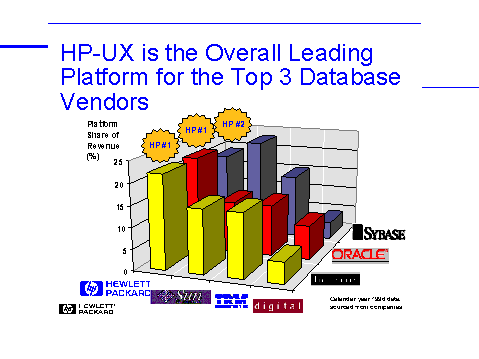
HP-UX’s status as platform revenue leader applies to many other leading ISV applications: SAP, Baan, PeopleSoft, D&B, and many others. Eight of the world’s top ten ISVs have HP-UX as their #1 revenue platform.
Several factors contribute to HP-UX being the leading platform for most ISVs. First is HP’s leading market share in the UNIX server market. ISVs, looking to leverage their development efforts and costs, naturally gravitate toward the HP-UX platform and its large installed base, to maximize sales opportunities.
Second, through its Developer Alliance Lab (DAL), HP has developed and maintains very strong and close relationships with larger ISVs. HP has similarly strong ties with other ISVs through the HP Partnership Program, which closely ties HP with resellers and systems integrators. These include equipment programs, technical support, and web-based information. HP shares with them early versions of HP-UX, so that they can best take advantage of new features and functionality in HP-UX and incorporate them into their applications early on: at or shortly after the release of HP-UX. Customers gain by having access to new application functionality soonest on HP-UX than on other UNIX platforms, which can give them a competitive advantage.
Investment protection
Investment protection has been a hallmark of HP-UX since it was first introduced in 1986. Over time, customers can spend up to twice as much on software as they do on hardware, in terms of people and dollars, and they want to be able to protect their substantial investments in applications software. HP-UX has the strongest record in the industry for providing application investment protection through forward binary compatibility, in which a fully-bound application developed on an earlier or current version of HP-UX is ensured to run smoothly on future versions of HP-UX. As a result, customers’ investments in application software are protected by extending the useful life of these applications across several versions of HP-UX. HP ensures that 32-bit PA-RISC applications following well-documented programming techniques will run on IA-64-based platforms without requiring modification.
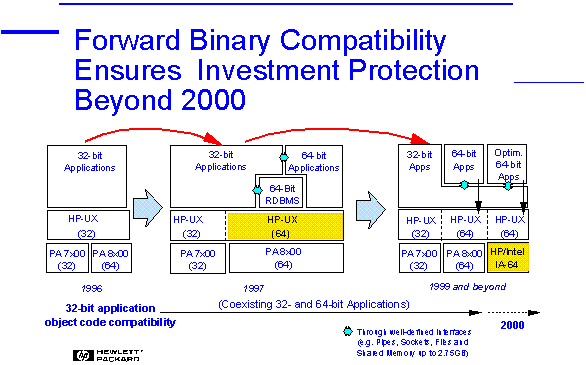
Openness and standards are key contributors for the growth of UNIX as a competitive alternative to proprietary mainframe computing environments. HP-UX leads the industry in the support and development of UNIX standards. It was the first UNIX to ship that is UNIX-95-branded, as specified by The Open Group, the standards body. HP-UX also complies with such industry standards as CDE, or Common Desktop Environment, HP-UX’s windowing environment; POSIX; and over 70 others.
Beyond its commitment to standards adoption and compliance, by virtue of its leading presence in the UNIX server market, HP has played a significant role in the development of standards for 64-bit UNIX. For example, HP’s Software Distributor technology was the basis of a standard recently endorsed by The Open Group and other leading UNIX vendors that permits software platform replication and standardization.
HP-UX futures
HP has ambitious plans to enhance HP-UX. During the remainder of 1998 and through to the end of 1999, HP will increase the PRISM functionality of HP-UX as indicated in the table below.
|
PRISM element |
Feature |
Benefit |
|
Performance and scalability |
|
|
|
Resilience |
|
|
|
Integration |
|
|
|
Security |
|
|
|
Manageability |
|
|
As the introduction of IA-64-based systems approaches, HP will continue to invest in yet higher degrees of both performance and scalability and resilience and high availability. As to performance, plans are to support 32- and 64-way SMP systems, using both PA-RISC and IA-64 processors. To ensure increase systems resilience and high availability, HP plans to incorporate in HP-UX protection domains, and on-line replacement and addition of memory, and CPU, to complement HP’s goals of achieving its goal of providing 99.999% uptime, which translated to just five minutes of unplanned downtime.
Endorsement by strategic partners
The current consolidation of the UNIX market in anticipation of the introduction of IA-64-based systems has been well chronicled in the industry press. Last April, HP jointly announced that Hitachi, NEC, and Stratus—three prominent hardware vendors—had embraced HP-UX as their UNIX of choice for their IA-64-based systems.
Concluding remarks
The combination of HP’s four-year strategic relationship with Intel in the joint development of IA-64, HP-UX’s current and planned new functionality as described above, and the endorsement by major industry partners ensure that HP-UX will be the de facto UNIX on IA-64.
For more information, see www.hp.com/go/hp-ux.
Feature comparison of HP-UX 10.20 and 11.0
|
10.20 |
11.0/32-bit |
11.0/64-bit |
||
|
Performance and scalability |
||||
|
Maximum CPUs supported |
14 |
16 |
16 |
|
|
32-bit PA-7x00-based systems |
Yes |
Yes |
||
|
64-bit PA-8x00-based systems |
Yes |
Yes |
Yes * |
|
|
V-2x00 |
Yes |
|||
|
File size, local |
128 GB |
1 TB |
1 TB |
|
|
File size, networked |
2 GB |
1 TB |
1 TB |
|
|
Physical RAM |
3.75 GB |
3.75 GB |
4 TB ** |
|
|
Shared memory |
2.75 GB |
2.75 GB |
8 TB |
|
|
Process data space |
1.9 GB |
1.9 GB |
4 TB |
|
|
File descriptors |
60,000 |
60,000 |
60,000 |
|
|
User IDs |
2 billion |
2 billion |
2 billion |
|
|
Kernel threads |
Yes |
Yes |
||
|
Performance Optimized Page Size |
Yes, on PA-8x00 |
Yes |
||
|
NFS v 3 |
Yes |
Yes |
||
|
NIS + |
Yes |
Yes |
||
|
Resilience and high availability |
||||
|
Journaled file system |
Yes |
Yes |
Yes |
|
|
Dynamic Memory Resilience |
Yes |
Yes |
Yes |
|
|
Dynamically Loadable Kernel Modules |
Yes |
Yes |
||
|
Integration |
||||
|
Java VM with JIT compiler |
Yes |
Yes |
Yes |
|
|
Netscape FastTrack |
Yes |
Yes |
Yes |
|
|
Oracle Web Application Server |
Yes |
Yes |
Yes |
|
|
Security |
||||
|
C2 compliant |
Yes |
Yes |
Yes |
|
|
Manageability |
||||
|
SAM |
Yes |
Yes |
Yes |
|
|
SAM enhancement for security and HA |
Yes |
Yes |
||
|
Applications |
||||
|
32-bit only |
Yes |
Yes |
||
|
32- and 64-bit |
Yes |
Yes |
||
|
Standards |
||||
|
UNIX-95 branded |
Yes |
Yes |
Yes |
|
|
Year-2000 compliant with patches |
Yes |
Yes |
Yes |
|
* Except D-class
** Limited by system configuration to 16 GB